
© Nikolay Krusser. (Click image for larger version)
The XII International Ballet Festival Dance Open
St Petersburg, Alexandrinsky Theatre, Oktyabrsky Concert Hall,
18-22 April 2013
www.danceopen.com
Margaret Willis on the 2012 Dance Open
The ‘Venice of the North’ put on its finest for its guests – the snows had melted the week before and the last remnants of the frozen canals floated in icy chunks beneath the many bridges. The sun shone brightly on golden domes, despite a chilly wind, and now, the end of April, the skies remained light until 10pm. For those not performing in the festival, the days were our own, the nights full of dazzling dancing.

© Vladimir Sidorenko. (Click image for larger version)
This year, Dance Open, one of the biggest and most exciting of all international dance festivals, celebrated its 12th year. Held in beautiful St Petersburg, the home of Russian ballet, the five-day event attracts students, dance companies, choreographers, ballet stars and guests from around the world, and is admirably organized by Ekaterina Galanova (general manager), Vasily Medvedev, (artistic director) and Olga Belenkis, (director). Originally set up to give talented ballet students the opportunity to take master classes with outstanding teachers from the Vaganova Academy, Dance Open has grown and now also includes exciting performances and a competition. The students this year came from the US, Brazil, Panama, Europe and Scandinavia for five intense classes with a final performance, and they also attended the Festival which offered a triple bill of contemporary works, a themed gala entitled ‘A History of Russian Ballet,’ and the ‘Gala of International Stars’ in which a regal gathering of some of the world’s top dancers vied for one of the prestigious prizes: a crystal replica of the bronze cast of Anna Pavlova’s foot. The judges for this event were nine company directors – Vladimir Malakhov, Denis Matvienko, Yuri Fateev, Boris Eifman, Igor Zelensky, Kevin O’Hare, Edward Clug, Galina Stepanenko and Aaron Watkin – and two choreographers – Hans van Manen and David Dawson.
Day 1: Night of One-Act Ballets
The first performance was a triple bill programme in the beautiful Alexandrinsky Theatre with three very different companies; Slovene National Theater Maribor, Semperoper Ballett Dresden and the Bolshoi Ballet from Moscow.

© Svetlana Tarlova. (Click image for larger version)
Choreographer Edward Clug has directed the Maribor company for the past ten years and in St Petersburg his dancers performed his reworking of Le Sacre du Printemps, which he created last year. His version of the hundred-year-old masterpiece harkens back even further than Nijinsky’s vision, to primeval days, where the simian factor was still part of early man. The curtain lifts to show an otherworldly landscape. The light is harsh, the air filled with chalky clouds of dust-like mist rising on the world’s beginnings. In two lines, the six boys and six girls rise up on tiptoe and slowly change places with each other in a choreographic game of chess. Stooped over, heads abruptly jolting alert as if listening to some unknown summons, they move in ungainly shuffles, one at a time, as though learning to walk. Their whole beings are whitened and their brief costumes make them look naked under the lights. The boys all sport beards, the girls pigtails and, from crouched-over position, they begin to jump in unison as in the original production. Their steps are very basic and repetitive and they move jerkily around the stage like zombies. There’s a lot of clustering and falling and at one point the boys catch their girls in rigid backwards falls, supported only with one hand on their necks until they touch the ground. Suddenly powerful jets of water spurt dramatically from above, catching the light and drenching the dancers. This enables them to splash, slide and swirl in the water, which is effective when the girls are twirled round by the boys and glide gracefully like swans along the floor when pushed. But, like the choreography, this gets somewhat repetitive, especially when more and more water is doused on them.
Clug pays token homage to Nijinsky’s choreography throughout his piece, though not with the same impetus or distinction. The Chosen One is pushed and pulled through the water like a rag doll, one moment jerking with hostility, fighting against the selection, the next, pulling at her arms and slumping with acceptance. As the music crescendos to its conclusion, her wet plaits are undone, and she is pulled down, tossed, and finally her body is sent sliding away across the puddle-strewn stage, far from the group which gazes in zombified stupor in the opposite direction.
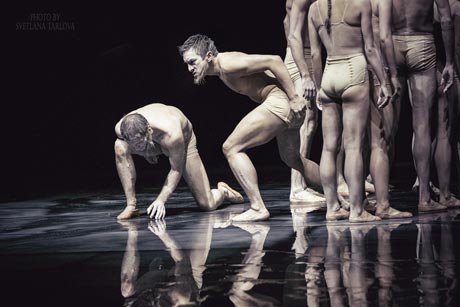
© Svetlana Tarlova. (Click image for larger version)
From the white of Maribor to the black of Dresden – with yet more clustering. Spazio-Tempo, created in 2010 for Semperoper Ballett Dresden by Jacopo Godani, an Italian born choreographer, has the dancers in black pants and see-through tops. This work also begins as a line-up – boys one side, girls on the other – and they come together, arms and bodies writhing like the rituals in a snake pit. To a modern score by ‘48nord’, the choreography is chopped into short episodes, sometimes with early blackouts on poses, and once midway in the performance, the curtain falls momentarily – all apparently the choreographer’s trademarks. The work pays homage to Forsythe technique with its lightning speed footwork, frenetic boneless body contortions and stabbing pointe work. Like McGregor, Godani rips the bodies out of their sockets in ‘way-past six o’ clock’ splits and makes his dancers move with quirky, yet neat action. In one interesting sequence, the ballerina is lifted high with her legs stretched in all directions, and is twisted inside out by the men in an episode that makes Manon’s brothel scene look like child’s play.
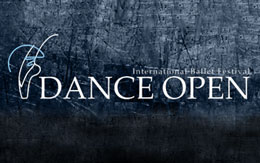 In sharp contrast both in style and mood came Yuri Possokhov’s Classical Symphony, danced by members of the Bolshoi Ballet – Artem Ovcharenko, Kristina Kretova, Semyon Chudin, Anna Tikhomirova, Mikhail Lobukhin and Anastasia Stashkevich. To Prokofiev’s brilliant score, the dancers exuberantly fly on and off the stage, with a great sense of fun. The girls wear mustard leotards with wired mushroom-shaped single tulle tutus; the boys are elegant in black tights and fashioned cropped jackets. Each was given his or her moment to shine in the spritely, energetic and daring choreography. Possokhov demands unusual moves from his dancers, all done with fast footwork – off-kilter body shapings that still remain classical, pirouettes that start floor level and spiral upwards, quirky and unexpected action such as throwing the girls down, then dragging them off. The three girls sparkled, especially Tikhomirova, who always looks so happy to be dancing, while the boys in the Gavotta – (the‘Romeo music’) – criss-crossed the stage one after another in exhilarating high flying, stretched jetes. The ballet has the vitality and fluidity of Balanchine’s ‘Symphony in C’ and the audience at Dance Open left the theatre with smiles on their faces.
In sharp contrast both in style and mood came Yuri Possokhov’s Classical Symphony, danced by members of the Bolshoi Ballet – Artem Ovcharenko, Kristina Kretova, Semyon Chudin, Anna Tikhomirova, Mikhail Lobukhin and Anastasia Stashkevich. To Prokofiev’s brilliant score, the dancers exuberantly fly on and off the stage, with a great sense of fun. The girls wear mustard leotards with wired mushroom-shaped single tulle tutus; the boys are elegant in black tights and fashioned cropped jackets. Each was given his or her moment to shine in the spritely, energetic and daring choreography. Possokhov demands unusual moves from his dancers, all done with fast footwork – off-kilter body shapings that still remain classical, pirouettes that start floor level and spiral upwards, quirky and unexpected action such as throwing the girls down, then dragging them off. The three girls sparkled, especially Tikhomirova, who always looks so happy to be dancing, while the boys in the Gavotta – (the‘Romeo music’) – criss-crossed the stage one after another in exhilarating high flying, stretched jetes. The ballet has the vitality and fluidity of Balanchine’s ‘Symphony in C’ and the audience at Dance Open left the theatre with smiles on their faces.
Day 2
A second showing of the triple bill, but I played hooky and trotted off to the Mariinsky to see a glorious Giselle. (see review)
Day 3: Gala – History of Russian Ballet
Past Dance Open galas have honoured great dancers. However this year the festival took on the awesome task of celebrating the choreographers and their exponents who helped to form Russian Ballet. In a greatly potted depiction of its historical roots, and accompanied by old photographs transmitted onto an elaborate picture frame, the gala presented diverse works from St Leon to Ratmansky with Petipa, Fokine, Gorsky and Grigorovich in between.

© Vladimir Cherenkov. (Click image for larger version)
First up was the 150-year-old and rarely seen ‘Animated Frescoes from the Little Humpbacked Horse’ by St Leon. This is a charming pas de quatre – delicate, old-fashioned in mannerisms but technically challenging for the dancers, demanding fastidious footwork. The four ballerinas – Anastasia Kolegova, Ekaterina Osmolkina and Elena Evseeva (Mariinsky), Anna Tikhomirova, (Bolshoi) – took turns showing off their terpsichorean talents in a friendly one-upmanship way, demonstrating flawless technique and Romantic-era poses. All were lovely but it was Anna again who shone, smiling and staying on upward flight like a bird.
Last year’s Grand Prix winner, Iana Salenko, teamed up with Dinu Tamazlacaru (both Staatsballett Berlin) to perform the soulful Act 2 duet in Esmeralda (Perrot/Petipa) where the gypsy girl has to dance for her lover and his fiancée. Salenko has a very expressive body and clearly conveyed her character’s anguish, especially when, drooping with despair, she boureed backwards from one side of the vast stage to the other, with gossamer-light and smooth action. Tamazlacaru made a kindly, loving partner with soaring jumps and neat stretched legs.

© Stas Levshin. (Click image for larger version)
Fokine’s ‘Dying Swan’ was performed by that prima of ballerinas, Uliana Lopatkina, with dignity and grace. It’s a party piece she has made her own, and she is regal and glorious in it.
No gala would be complete without the Grand Pas from Gorsky’s Don Quixote. In this, the Mikhailovsky Ballet’s Leonid Sarafanov teamed up with the Bolshoi’s fast rising star, Kristina Kretova, and the corps de ballet of the National Opera of Ukraine. Anna Tikhomirova danced a joyful: variation as Kitri’s friend. Sarafanov, seen recently in the role in London, has possibly the most beautiful line of any male dancer today. His tours en l’air are unforced and high, and he lands with softness in a perfect 5th. His jetes are powerful, stretched and far-reaching, and everything he does is with great elegance. Kretova is an assured ballerina who showed off terrific balances, though her performance lacked Kitri’s sparkle.
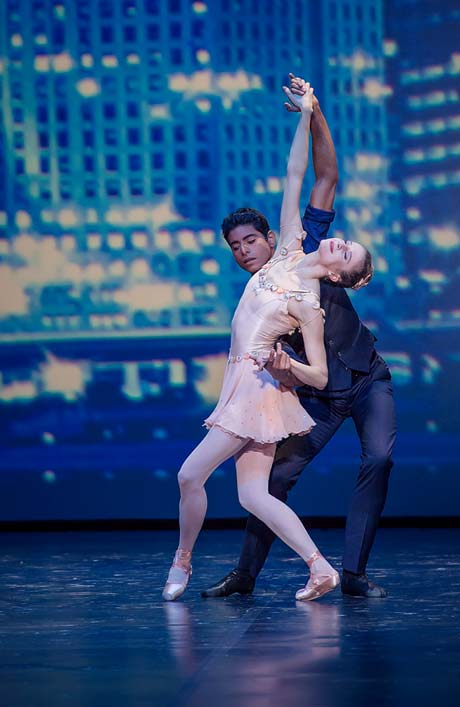
© Vladimir Cherenkov. (Click image for larger version)
Students of all ages from the Vaganova Academy, celebrating its 275th year, showed off their lessons with polish and dedication in Larionov’s ‘Great Waltz’, while former pupil, George Balanchine, was the choreographer of the next piece. New York City Ballet’s Sterling Hyltin and Amar Ramasar performed a slick and smooth ‘The Man I Love’ and boy! did I love Amar at first sighting. He has that easy, natural, fluid way of moving in the Astaire/Kelly mode, where his whole body is enveloped with musicality. I was transfixed by him, but I did watch Sterling who also moves well and has a lovely line and lyricism in her dancing.

© Vladimir Cherenkov. (Click image for larger version)
To finish off the first half and to send us out smiling, some of the Bolshoi dancers performed the Basque Dance from The Flames of Paris (Vainonen) with great gusto and enjoyment. Mikhail Lobukhin, Denis Savin and Anastasia Meskova stomped their way for the enthusiastic flag waving Ukrainian corps, who kept the pace going. The timid Anastasia Stashkevich was invited to join in and the pace got faster and faster, so that when the music and dancers finally stopped, their costumes kept sashaying.

© Vladimir Cherenkov. (Click image for larger version)
The second half saw the start of the Soviet era with old favourites like Asaf Messerer’s Spring Waters, spiritedly danced by Evseeva and Marat Shemiunov (Mikhailovsky), and Zakharov’s ebullient Gopak performed enthusiastically by the Bolshoi’s Denis Medvedev. Leonid Yacobson’s Choreographic Miniature ‘Vienna Waltz’ was fun and depicts the flirtations of a dapper gentleman in top hat with a demure young girl, and was well acted and danced by Osmolkina and Maxim Zyuzin

© Vladimir Cherenkov. (Click image for larger version)
Stars burst and fell as the backdrop for the adagio from Leonid Lavrovsky’s immortal Romeo and Juliet. Evgenia Obraztsova (Bolshoi) makes an ideal Juliet. Petite and seemingly fragile, lyricism pours throughout her whole body and, as in all her roles, she offered an aura of wonderment and excitement. Her technique is liquid and her line is always elegant. She is a perfectionist and a hard worker – and it shows. Igor Kolb (Mariinsky ) made a devoted Romeo, entering with full dramatic impact in his cape and continuing to impress his young love with high leaps and spinning turns. The pas de deux was beautifully executed and deserved the cheers it received.

© Vladimir Cherenkov. (Click image for larger version)
Yuri Grigorovich has been a great name in Soviet ballet for over half a century and the Bolshoi’s Anna Tikhomirova, and Artem Ovcharenko danced the Tango from his Golden Age, both exuding the sex appeal and charisma needed for the piece. Anna was tossed and turned upside down, ran up Ovcharenko’s body to sit on his shoulders and sliced the air with her long legs while he showed perfect harmony in line, technique and characterization.
Paris Opera star, Isabelle Ciaravola, and Yuri Smekalov (Mariinsky) performed the final scene from Onegin by Vasily Medvedev, the artistic director of Dance Open, and also a prolific choreographer. Slightly different to Cranko’s popular version, (but closer to Pushkin’s text,) this also was powerful in emotion and drama, clearly showing Olga’s turmoil in rejecting Onegin’s desperate pleas.

© Vladimir Cherenkov. (Click image for larger version)
Ciaravola is a beautiful ballerina with flowing lines and conveys her every emotion in her pristine dancing. Smekalov showed himself a strong actor, tormented with the fear of losing Tatiana, and her final command for him to leave left us all breathless.

© Stas Levshin. (Click image for larger version)
The Bolshoi returned with the slow movement of Possokhov’s Classical Symphony – not my favourite moment in the otherwise scintillating ballet. And former Bolshoi director Alexei Ratmansky’s contribution to the historical programme was a fragment from ‘Seven Sonatas’ which was danced by American Ballet Theatre’s Luciana Paris and Herman Cornejo. She moves with great grace, her white dress with crimped hem flowing around her. Like Balanchine’s ‘Tarantella’, this duet was perpetual motion, with the two dancers flying on and off the stage at great speed and with energetic fervour.

© Vladimir Cherenkov. (Click image for larger version)
Ending the evening was the Grand Pas d’Action from La Bayadere by Petipa, Chabukiani and Natalia Makarova, who sadly, at the last moment, was unable to attend the festival. However, the performance was a fitting tribute to her contribution to the Russian ballet world.
Anastasia Kolegova and Denis Matvienko, with his corps from National Opera of Ukraine, presented a polished extract with all the fireworks. Matvienko is a splendid dancer to watch. He speeds around the stage like a torpedo, polishes off multiple pirouettes with pzazz, and is an elegant partner. Kolegova has sharp neat technique and performed with musicality, especially in her impressive grand fouette releve en tournant.
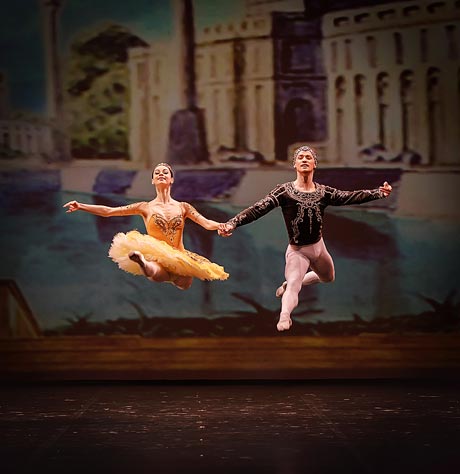
© Vladimir Cherenkov. (Click image for larger version)
Day 4: The Gala of International Ballet Stars
And so to the final night: the Gala and competition. Here the 11 judges would choose who was to receive the seven crystal awards from the dancers of 11 classical extracts and the one spirited, Spanish flamenco, contribution from Elena Algado, Miguel Angel Corbacho and Entredos Ballet Espagnol.
The Grand Prix was won by Lucia Lacarra who performed the duet from John Neumeier’s ‘Lady of the Camelias’ with Marlon Dino, (both from Bavarian State Ballet.) Lacarra immersed herself in expressive, dramatic dancing which showed off her assured technique, and mature elegance. She gave a splendid and fulfilling performance.

© Stas Levshin. (Click image for larger version)
Mr Virtuoso award went to Joseph Gatti for his performance in the show-stopping Stars and Stripes pas de deux with Ashley Bouder, who picked up the Ms Virtuoso Award. Together they enthralled the audience with Balanchine’s sparkling and comically clever piece. Gatti was so casual yet was always there to catch Bouder. His solo was full of fun and tricks and Bouder kept up with him with her slick fast turns. They whizzed around the stage in their Technicolor costumes with true American ‘look at me’ confidence and style. Gatti had also danced the Grand Pas from Flower Festival in Genzano with Obraztsova which opened the evening, but their dancing was not quite as crisp as the Bournonville style – though they both had sunny smiles throughout.
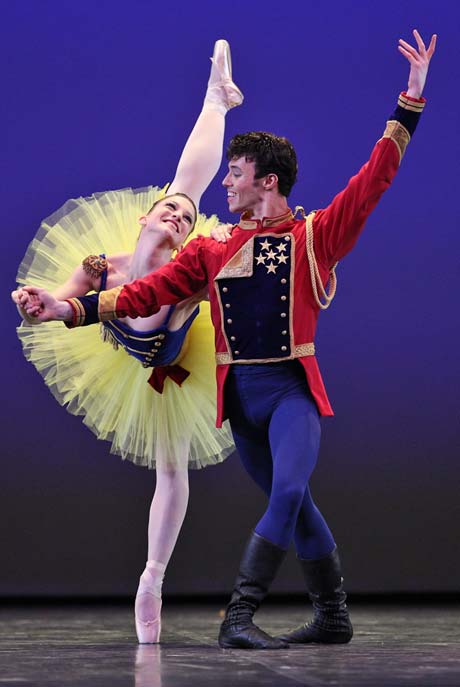
© Stas Levshin. (Click image for larger version)
Herman Cornejo performed the Diana and Acteon pas de deux with last year’s Grand prix winner, Iana Salenko. I’ve seen more animated performances of this duet – the fire was missing from his Acteon and his jumps were not as slicing as Yonah Acota’s (last year’s winner). But still the judges awarded him the Mr Expressivity prize.
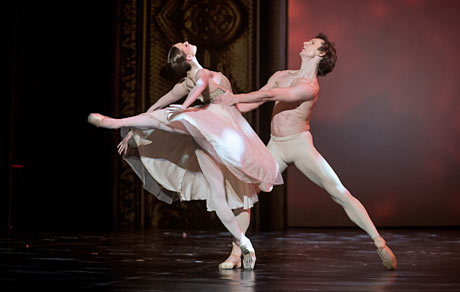
© Nikolay Krusser. (Click image for larger version)
The feminine equivalent, Ms Expressivity, was given to the Bolshoi’s Olga Smirnova for her all-too-short performance of Roland Petit’s Thais. She is the epitome of grace and lyricism and her performance was silky smooth with well-positioned lifts thanks to her partner, Semyon Chudin.
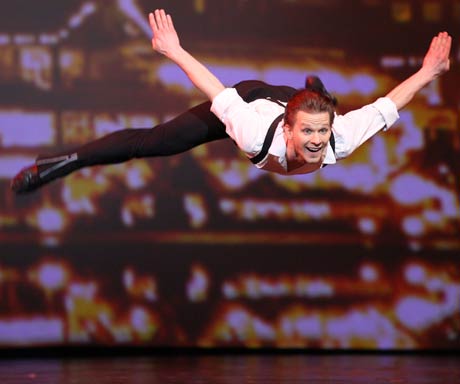
© Stas Levshin. (Click image for larger version)
The audience was given a chance to vote as they left the theatre and this year chose Daniel Ulbricht whose suave dancing in Peter Martins’ ‘It Shoulda Been Me’ showed his talents off well. He later appeared in an extract from Walpurgis Night, leaping and conjuring up the bacchanalian atmosphere with devilish glee.

© Nikolay Krusser. (Click image for larger version)
Two couples won the Best Duet Award – Elisa Cabrera and Mikhail Kaniskin (Staatsballet Berlin) who performed Transparente (chor. Savkovic; music Fado) with graceful fluidity and drama – an interesting piece to watch especially when danced so well. The other couple, Jurgita Dronina and Fabien Voranger, danced the duet from Dawson’s A Sweet Spell of Oblivion and gave a polished performance in this flowing duet danced in front of a backdrop of clouds.
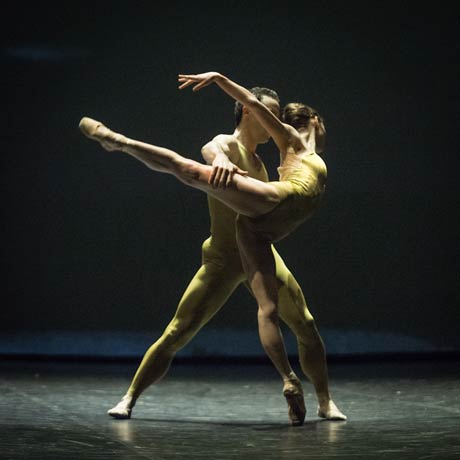
© Nikolay Krusser. (Click image for larger version)
Other performers who did not get prizes this year showed off some great dancing and congratulations again to the Ukrainian corps de ballet who added to many of the longer extracts.
The interesting ‘Fragment from Talisman’ filled in details not normally seen in galas. Petite and pretty, Anastasia Stashkevich was radiant in her pale blue tunic and showed herself off in a bouncy solo done with radiant style. She, like us, was wowed when Yonah Acosta sprang onto the stage. Looking so like a young Carlos in style and panache, he thrust himself into the air with complicated leaps and even more complicated endings. His speedy screwdriver turns finished with slow controlled endings, which sent the audience cheering.
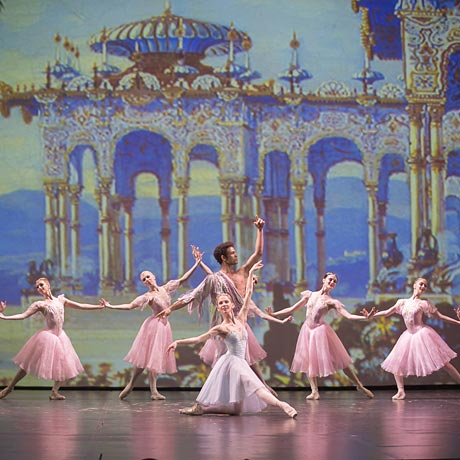
© Nikolay Krusser. (Click image for larger version)
Alicia Amatriain and Jason Reilly performed the bedroom pas de deux from Cranko’s Onegin –a bit challenging to conjure up the atmosphere when there was neither mirror, nor props. But they danced convincingly and later changed style completely for Fanfare LX (chor. D.Lee) where they entwined and separated in shiny red costumes.
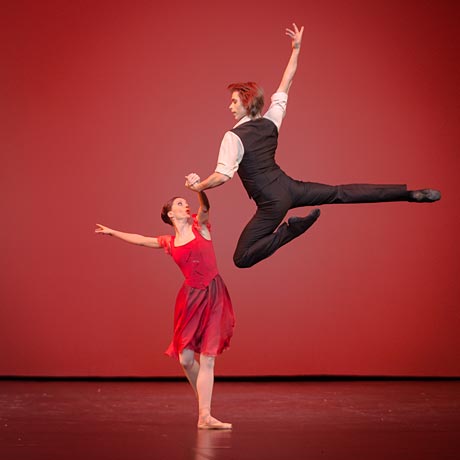
© Nikolay Krusser. (Click image for larger version)
A budding young Mariinsky dancer/choreographer, Anton Pimonov, created Triangle (to Brahms) which was performed by the Bolshoi Trio: Tikhomirova, Kretova and Ovcharenko. The girls showed off their technical feats amicably to each other until the handsome Ovchrencko arrived. Then it was the eternal triangle with plenty of fun and games. He has an easy high jump and classy style and enjoyed watching the girls vie for his attention. Kretova was very animated and saucy and assured in all her steps. Tikhomirova, the quieter of the two, again danced with impressive unforced and lyrical technique. It was a good party piece with its added comedy.

© Stas Levshin. (Click image for larger version)
Anna Tsygankova and Matthew Golding (Dutch National Ballet) performed a duet from Christopher Wheeldon’s spanking new Cinderella. It contains many tricky lifts and Golding (the ballet world’s Brad Pitt!) in his bright red ‘Nutcracker’ tunic, white tights and boots performed them well, making Anna look feather light and delicate. They also performed in Walpurgis Night, which made an exciting end to the gala. The stage filled with nymphs and satyrs and Golding showed off some good controlled high leaps to a delicate and spirited Tsyanovkova who was especially good in her hopping dance with the satyrs (excellent acting from them) and in her flying jetes.

© Vladimir Sidorenko. (Click image for larger version)
The Awards were presented in the impressive Marble Hall of the Russian Museum of Ethnography after the performance, with two unofficial prizes being given by a well-known furrier. Anna Tsygankova received a beautiful mink stole and Hans van Manen was given a fur-edged Czar’s cap which suited him well, but I doubt if he will wear it often.
We leave you with one, final, happy picture…

© Vladimir Sidorenko. (Click image for larger version)












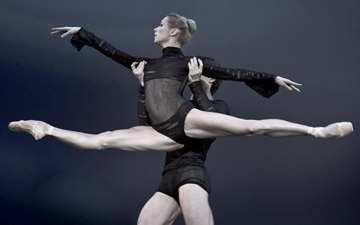



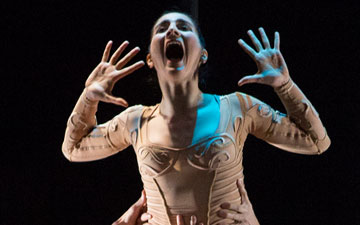
I was there and this superb article brought it all back vividly.
Thank you for the excellent description and the remarkably good photos
Olga G. de Smoak